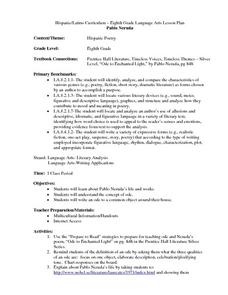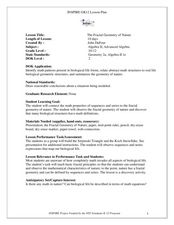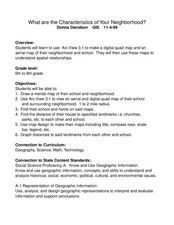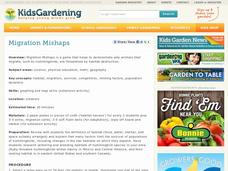Curated OER
I am Canadian
Students explore the concept of ethnicity through a survey, duscussion and a self-examination of ethnicity and diversity and what it means to them.
Curated OER
Pablo Neruda
Eighth graders explore the life and works of Pablo Neruda. They complete an author map concerning his personal and professional life. Students identify the key components of an ode. They write an ode to a common object around their...
Curated OER
What's Matter?
Students explore the definition of matter. In exploring matter lesson students get into groups and navigate the Internet to answer questions.
Curated OER
The Fractal Geometry of Nature
Students identify patterns found in nature. In this algebra lesson, students model situation in nature using fractals. They investigate biological geometric structures and draw conclusion based on geometric concepts.
Curated OER
Rooting One's Way To Meaning
Students use a thesaurus on the internet to explore the meanings of Greek and Latin roots. They find definitions of given words, draw a concept map for root words, and write four synonyms for each word. Students discover how Latin and...
Curated OER
Chemical Changes or Reactions
In this chemical changes worksheet, young scholars create a concept map for chemical changes or reactions. They indicate the definition, the description, they give examples and they give non-examples in a graphic organizer.
Curated OER
What Are The Characteristics of Your Neighborhood?
Students make a mental map of their neighborhood. Using a software program, they make an aerial and digital map of their school and locate their school on given maps. In groups, they calculate the distances to various locations and...
Curated OER
Alternative Energy
Students identify the five major alternative energy sources. In this physical science lesson, students assess the advantages and disadvantages for each type of energy. They complete a concept map using information they researched.
Curated OER
"Region" Out to Everyone: Geographic Regions Defined
Students define the term region. They collect data about New England after watching a short video. They organize the information into a regional concept map. They draw conclusions based upon their data collection and analysis.
Curated OER
Personal Fitness
Students research important personal fitness and sport concepts through note taking, internet research, data collection, and the website Quia. Development of concept maps are also encouraged.
Curated OER
What Is A Community?
Second graders write a collective definition of the term, "community". They create a poster illustrating their definition of community and how communities enable people to meet their basic needs and satisfy their wants. They discuss...
Curated OER
Children's Literature
Introduce the students to basic economic concepts and types of economic systems and develop the an understanding of how economic choices involve costs and consequences; provide introduction to rural America circa 1920 and compare to our...
Curated OER
Local Area - Is the Land Connected to Us?#144
Students examine how human influences have affected the Connecticut River Valley. They determine what a region is in relation to its human influences. They label the important human features of this region including dams, canals, and...
Curated OER
Rapping Regions in America
Students determine what designates a place as a region. They apply their criteria for a region to the US map. They work in groups to write a rap about their region that describes its organization, type and structure.
Curated OER
I am Canadian
Students complete a survey about ethnic origin and discuss the results. They discuss the definition of ethnicity and the pros and cons of being of a certain ethnic group.
Curated OER
Meteorology
Seventh graders examine the job of meteorologists. They decide which characteristics of the atmosphere that meteorologists focus on. They use local weather maps from newspapers to predict weather in their area.
Curated OER
Dreaming of a Healthy City
Ninth graders design a healthy city. They identify the essential elements of a city and describe how climate and geography can determine the layout of a city. They create a blueprint of their design and share in small groups.
Curated OER
Puberty/Adolescence, Day 3: "Am I Normal?"
"Am I normal?" Bring this topical discussion to your health or teen issues class, who might be struggling with their developing identities. Learners discuss relationships, including acquaintences, friendships, girlfriends, boyfriends,...
EngageNY
Why Move Things Around?
Explore rigid motion transformations using transparency paper. Learners examine a series of figures and describe the transformations used to create the series. They then use transparency paper to verify their conclusions.
Scholastic
Biographical History
Elementary learners study and research an important historical figure. They research a historical figure and use a four square organizer to take notes. They develop a timeline and poem that reflects the life of the historical figure....
Curated OER
Applying the Pythagorean Theorem to find Distances Between Cities
Young scholars solve problems using the Pythagorean Theorem. In this geometry lesson, students identify the Pythagorean Triple and use it to solve real life problems.
National Gardening Association
Migration Mishaps
Elementary ecologists pretend to be migratory hummingbirds. They fly between wintering and nesting grounds, trying to reach a habitat haven. In a musical-chair fashion, some birds will miss out, and are removed from the game. To further...
Curated OER
Short Story Elements
Pupils engage in a lesson that investigates the elements that are necessary in a short story. Each element is covered separately while they take notes for each part. Then the teacher points out each element while reading a short story to...
Curated OER
League of Nations
Ninth graders examine the purposes and mandate system of the League of Nations. They watch a PowerPoint presentation on the mandate system and complete a fill-in-the-blank worksheet, and participate in a "pick your side" activity.

























